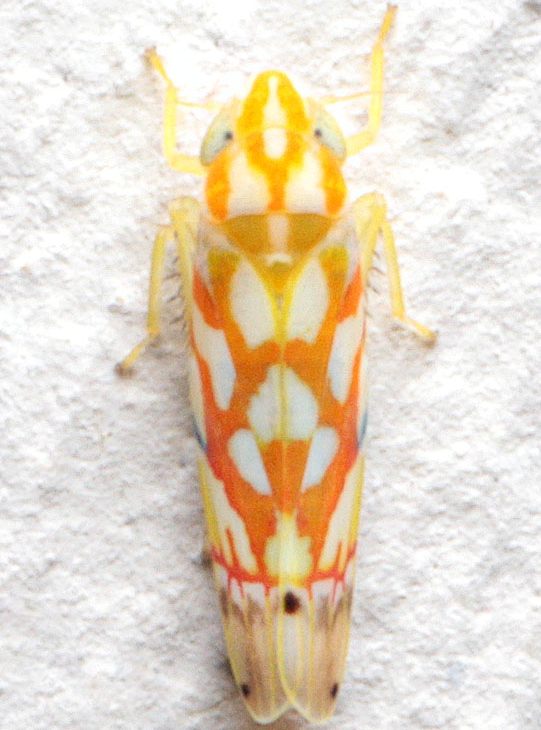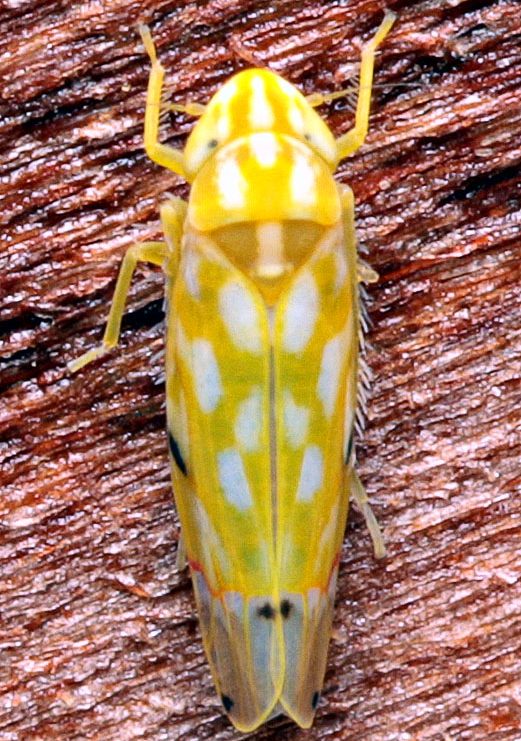| Comment: This page serves as an umbrella for any individuals of Erythroneura that have interconnected orange wing markings. In the eastern and central regions of North America, there are a number of Erythroneura species that have very similar wing patterns, so similar that it is unlikely a reliable identification can be made between these species without dissecting an individual and looking at genitalia. Below are the Erythroneura species that are encompassed by this page, with text taken from Dmitriev & Dietrich, 2007 illustrating the descriptions of color and pattern for each species. Links exist for the profile page of each species.
E. aza- Dorsum yellow or white. Color pattern red or orange. Vertex with orange parallel submedial lines (often with lateral branch). Vertex midline pale. Anteclypeus pale, concolorous with rest of face. Pronotum with Y- or V-shaped medial vitta. Mesonotum pale, with dark lateral triangles, apex dark, contrasting with adjacent pale areas. Thoracic venter entirely pale or with dark mesosternum, remainder pale. Forewings with oblique vittae usully forming continuous zigzag pattern, without crossbands. Clavus with separate basal and distal vittae. Forewings with dark spot on costal margin. Forewing apical cell II with distal spot, inner apical cell with brown spot basally.
E. beameri- Dorsum yellow or white. Color pattern red or orange. Vertex with oblique lateral vittae. Vertex midline pale. Anteclypeus pale, concolorous with rest of face. Pronotum with Y- or V-shaped medial vitta. Mesonotum pale, with dark lateral triangles, apex dark, contrasting with adjacent pale areas. Thoracic venter entirely pale. Forewings with oblique vittae usully forming continuous zigzag pattern, without crossbands. Clavus with separate basal and distal vittae. Forewings with dark spot on costal margin. Forewing apical cell II with distal spot, inner apical cell with brown spot basally.
E. bakeri- Dorsum yellow or white. Color pattern red or orange. Vertex with orange parallel submedial lines (often with lateral branch). Vertex midline pale. Anteclypeus pale, concolorous with rest of face. Pronotum with Y- or V-shaped medial vitta. Mesonotum entirely pale, apex concolorous with rest of mesonotum. Thoracic venter with dark mesosternum, remainder pale. Forewings with broken oblique vittae, without crossbands. Clavus with separate basal and distal vittae. Forewings with dark spot on costal margin. Forewing apical cell II with distal spot, inner apical cell with brown spot basally. See here for dissected specimens of E. bakeri.
E. kennedyi- Dorsum yellow or white. Color pattern red or orange. Vertex with orange parallel submedial lines (often with lateral branch). Vertex midline pale. Anteclypeus pale, concolorous with rest of face. Pronotum with Y- or V-shaped medial vitta. Mesonotum pale, with dark lateral triangles, apex dark, contrasting with adjacent pale areas. Thoracic venter entirely pale. Forewings with broken oblique vittae, without crossbands. Clavus with separate basal and distal vittae. Forewings with dark spot on costal margin. Forewing apical cell II with distal spot, inner apical cell with brown spot basally.
E. kerzhneri- Dorsum yellow or white. Color pattern red or orange. Vertex with orange parallel submedial lines (often with lateral branch). Vertex midline pale. Anteclypeus pale, concolorous with rest of face. Pronotum with Y- or V-shaped medial vitta. Mesonotum pale, with dark lateral triangles, apex dark, contrasting with adjacent pale areas. Thoracic venter entirely pale. Forewings with broken oblique vittae, without crossbands. Clavus with separate basal and distal vittae. Forewings with dark spot on costal margin. Forewing apical cell II with distal spot, inner apical cell with brown spot basally.
.
Additionally, E. vitifex is very similar and some individuals of this species could belong in this group. However, E. vitifex tends to have fairly thick wing markings that should, in many cases, allow for a species identification. Here is the description of E. vitifex though, showing how similar this species can be to the rest.
E. vitifex- Dorsum yellow or white. Color pattern red or orange. Vertex with orange parallel submedial lines (often with lateral branch). Vertex midline pale. Anteclypeus pale, concolorous with rest of face. Pronotum with Y- or V-shaped medial vitta. Mesonotum pale, with dark lateral triangles, apex dark, contrasting with adjacent pale areas. Thoracic venter with dark mesosternum, remainder pale. Forewings with oblique vittae usully forming continuous zigzag pattern, without crossbands. Clavus with separate basal and distal vittae. Forewings with dark spot on costal margin. Forewing apical cell II with distal spot, inner apical cell with brown spot basally. |

 »
»




 »
»


